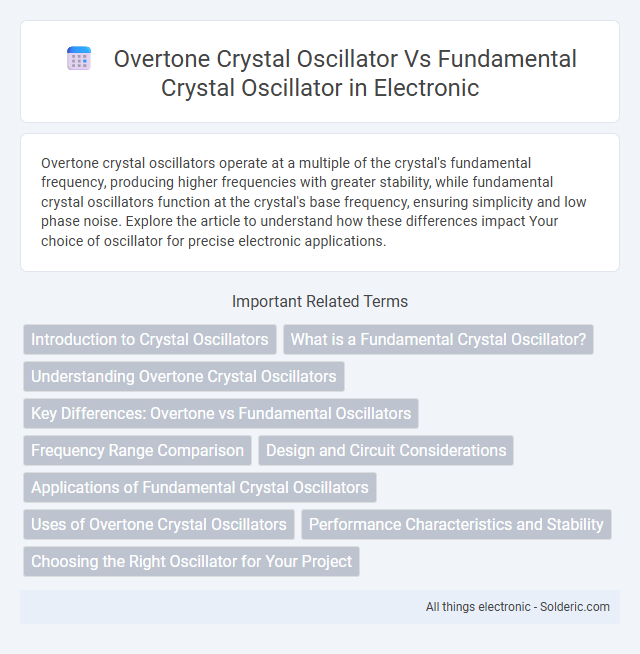Overtone crystal oscillators operate at a multiple of the crystal's fundamental frequency, producing higher frequencies with greater stability, while fundamental crystal oscillators function at the crystal's base frequency, ensuring simplicity and low phase noise. Explore the article to understand how these differences impact Your choice of oscillator for precise electronic applications.
Comparison Table
| Feature | Overtone Crystal Oscillator | Fundamental Crystal Oscillator |
|---|---|---|
| Operating Frequency | Higher frequencies by using overtone modes (3rd, 5th, etc.) | Lower frequencies at the crystal's fundamental frequency |
| Frequency Stability | Good but slightly less stable due to overtone operation | Excellent stability at fundamental frequency |
| Complexity | More complex circuit design for overtone selection and filtering | Simpler circuit design |
| Size | Usually smaller for same frequency due to higher overtone modes | Larger crystal sizes needed for low fundamental frequencies |
| Application | Used in high-frequency communications, RF systems | Used in low-frequency timing applications |
| Power Consumption | Generally higher due to complex circuitry | Lower power consumption |
Introduction to Crystal Oscillators
Crystal oscillators utilize quartz crystals to generate precise frequencies, with fundamental oscillators operating at the crystal's natural resonant frequency for stability and low phase noise. Overtone crystal oscillators, by contrast, excite the crystal at higher harmonics of its fundamental frequency, enabling operation at multiples of the base frequency while maintaining crystal accuracy. This allows overtone oscillators to achieve higher frequency outputs without requiring smaller physically cut crystals, balancing frequency range and performance in electronic timing applications.
What is a Fundamental Crystal Oscillator?
A Fundamental Crystal Oscillator operates by vibrating the quartz crystal at its primary resonant frequency, offering high accuracy and stability for timekeeping and frequency control applications. It typically functions at lower frequencies compared to overtone crystal oscillators, which utilize higher harmonic frequencies for increased precision. Your choice of oscillator depends on the required frequency range and application, with fundamental oscillators preferred for simpler, lower-frequency needs.
Understanding Overtone Crystal Oscillators
Overtone crystal oscillators operate at frequencies that are multiples of the crystal's fundamental frequency, enabling more precise and stable high-frequency signals compared to fundamental crystal oscillators, which function at the crystal's natural resonant frequency. You can achieve enhanced frequency stability and reduced phase noise in communication and signal processing applications by utilizing overtone oscillators, especially for frequencies beyond the crystal's fundamental range. Selecting the right oscillator type hinges on your specific requirement for frequency accuracy, signal purity, and operational frequency band.
Key Differences: Overtone vs Fundamental Oscillators
Overtone crystal oscillators operate at higher harmonic frequencies, typically multiples of the crystal's fundamental frequency, enabling more precise frequency control and higher stability in RF applications. Fundamental crystal oscillators work directly at the crystal's natural frequency, offering simpler design and better signal purity but limited frequency range. The choice between overtone and fundamental oscillators depends on the required frequency, phase noise performance, and application-specific stability demands.
Frequency Range Comparison
Overtone crystal oscillators operate at multiples of a crystal's fundamental resonant frequency, enabling access to higher frequency ranges typically from 10 MHz up to several hundred MHz, while fundamental crystal oscillators function at the crystal's natural resonant frequency, generally limited to a lower range around 1 MHz to 30 MHz. The overtone mode achieves higher frequencies by exciting harmonic modes, offering enhanced precision and stability in RF applications where fundamental oscillators fall short due to physical crystal size constraints. Frequency range comparison highlights overtone oscillators' advantage in achieving GHz-range signals with compact crystals, crucial for modern communication and signal processing systems.
Design and Circuit Considerations
Overtone crystal oscillators use higher-order harmonics of the crystal's natural frequency, requiring precise tuning circuits and additional frequency-selective components to ensure stable oscillation at the overtone frequency. Fundamental crystal oscillators operate at the crystal's primary resonant frequency, resulting in simpler circuit design with fewer components and lower sensitivity to component variations. The design complexity of overtone oscillators demands careful consideration of oscillator gain, load capacitance, and crystal drive level to prevent spurious oscillations and maintain signal purity.
Applications of Fundamental Crystal Oscillators
Fundamental crystal oscillators are widely used in applications requiring stable and low-frequency signals, such as microcontroller clocks, digital watches, and RF communication systems. Their ability to operate at the crystal's natural resonant frequency ensures high precision and minimal phase noise, which is critical for timing circuits and frequency references. If your project demands reliable and accurate timing at standard frequencies, fundamental crystal oscillators provide a robust and cost-effective solution.
Uses of Overtone Crystal Oscillators
Overtone crystal oscillators are primarily used in applications requiring higher frequency stability and precision, such as in RF transmitters, communication systems, and frequency synthesizers. They operate by vibrating at a harmonic frequency rather than the fundamental frequency, enabling more accurate signal generation at higher frequencies. Your choice of overtone oscillators can enhance performance in devices demanding strict frequency control and low phase noise.
Performance Characteristics and Stability
Overtone crystal oscillators deliver higher frequencies by operating at multiples of the fundamental frequency, providing better phase noise performance and improved frequency stability in high-frequency applications. Fundamental crystal oscillators operate at their base resonant frequency, offering superior frequency accuracy and lower power consumption but limited frequency range. Your choice depends on the required frequency precision and stability, with overtone oscillators suited for GHz-level stability and fundamentals excelling in lower frequency, stable environments.
Choosing the Right Oscillator for Your Project
Overtone crystal oscillators operate at higher harmonics of the crystal's fundamental frequency, offering improved frequency stability and reduced phase noise, making them ideal for high-precision radio frequency applications. Fundamental crystal oscillators, working at the crystal's natural resonant frequency, provide simpler design and lower cost, suitable for general-purpose timing and control circuits. Evaluating your project's frequency accuracy requirements, power consumption, and complexity helps determine whether the superior spectral purity of overtone oscillators or the straightforward implementation of fundamental oscillators best fits your needs.
Overtone crystal oscillator vs Fundamental crystal oscillator Infographic

 solderic.com
solderic.com